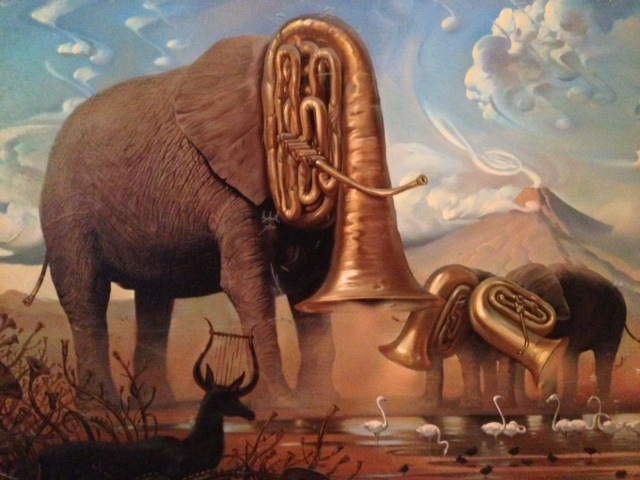遗巷
远眺近窥
Changing Taste
by Lostalley
This Saturday afternoon, I had a brunch with a friend at Bonaparte, a French bistro in Georgetown, DC. The restaurant is a stone’s throw away from a block of art galleries, antique shops and fashion boutiques. It’s been quite a while since my last visit. I felt like in a drastically different world. All galleries were in unison on a brighter exterior with vibrant colors and loud logos. The art works inside shared a heightened bourgeois taste with so-called “life-enhancing art” (politically uncontroversial and generically decorative) instead of conceptual and experimental art. The dynamic and diversity I saw years ago were replaced by egalitarian and boring themes. One-size-fits-all commercial art by dealers who seem to hate risk-taking. I felt ambivalent, musing how the art scene has evolved in the last 10 years and its ramifications for the future.
I drove into a narrow alley to look for a gallery owned by a Ukraine artist who was trained at Moscow Fine Arts Academy. The gallery was gone and a dance studio filled in there. The neon sign was flashing rhythmically, like comets sliding through the night sky. A used bookstore, a florist, an upholstery, and a cafe with dubious decor, lined up like toy soldiers in a fairytale. Looking through the hazed car window, I felt like a lost tourist in a strange city. Nostalgia and bewilderment disoriented me. Slowly, the whole alley turned misty and invisible, stores deformed into curved creatures, street lamps shed yellowish light......a George Ault painting in 1940s emerged. Ault family fortune was lost in the stock market crash in 1929. Subsequently, he moved into a cabin in Woodstock, New York, and most of his best works were created there. Deprivation of wealth nourishes artistic talent. Revisiting a familiar place in a peculiar emotional flow may induce a unique sentimental gratification and philosophical pondering. This small alley of Federal and Georgian style row houses built in 1930s started dancing in a movie-flashback style, silhouetted against dusk illumination of January 2015. My car willfully immobile, my cigar barely inflammable, images of another encounter from the opposite shore of the Pacific wandered across......
Shanghai as well as China is racing against time to make up for its utopian austerity during Mao's era. Desire to restore her old glory, coupled with West's greed to capitalize on China's vast market, has been pushing the already fragile environmental and moral equilibrium to the brink of collapse. The irony is that Chinese elite know the dilemma acutely but march forward to the cliff regardless. This can only be comprehended by a typical Chinese dichotomy of faith: a survivalist optimism that conflict between nature and man will be solved eventually on its own course; and a Buddhist fatalism that amoral cycle of life and death predetermines human mandate.
Shanghai appears to be in a state of taste shaping, architecturally. The time-worn melange of French villa, English apartment, Russian Orthodox church, surrounded by Chinese lane house, century-old temple and socialist-style building, is over-shadowed by a generic gentrification of office high-rises, mega malls and gated communities. The culprit is Global Capitalism. Today, it's impossible to walk in the main streets of Shanghai (Beijing too) without sight of western luxury brands. Louis Vuitton has outdone Mao in brainwashing. Conspicuous Consumption has replaced Cultural Revolution with the same fever. Hence the ultimate mix-match: the scene of beaming BMWs chased by boisterous bicycles; the scent of Chanel perfume engulfed by smell of cabbage pickle; couture and haute vs. tacky and vulgar. Passing through the Bund never fails to make me wonder, is Shanghai Oriental Pearl Tower (or Seattle Space Needle and Toronto Tower for that matter), an architectural enhancement or a regrettable eyesore? Would the futuristic skyline of Lu Jia Zui in Pudong stand the time test and settle as an integral complement to the venerable Bund whose statue elevates as time goes by? Not all buildings are created equal. Faddish means finish. Fashionable Shanghai today is more likely to be viewed as a superficial Disneyland than a cultural wonderland tomorrow. Prove me wrong, time.
I went home and left again in a bone-chilling cold, to a WholeFoods nearby. I like to shop there before closing, an inexplicable habit kept over the years. In this late hour, the store looked deserted with only a score of customers and yawning cashiers. The bright-whiteness of fluorescent light cast a soothing glare against the symmetric shelves filled with immense colorful labels. Slightly haunting but serene, an otherwise utilitarian and industrialized setting was transcended into a William Eggleston photograph: a loneliness, chosen but not imposed; an individualistic stance, unknowing but not unwilling; a materialistic lifestyle, alienating but not unrewarding. Strangely, instead of finding this apathetic ambiance that can be best described as Visual Commercial sterile, I feel a kinship. A byproduct of my existential experience in an adopted country that yields sentimental value perceived as Art Americana, perhaps? In this light, what is deemed as unappealing or even repulsive today may indeed reappear aesthetically acceptable, or even enticing, in foreseeable future. New will replace old. Change is constant. But in 20 years, would the transformation of Shanghai, or the art district in Georgetown warrant a renewed definition of beauty, regardless of artistic merits and classic standards accepted by one era but rejected by another?
On my way home after the grocery shopping, through the windshield, I saw white fume from a truck ahead wavering up in darkness like the last smoke from an extinguished cigarette, reminiscent of aurora (Northern Light) I once saw in the Arctic. Perception is a tricky thing.
02/01/2015, Bethesda, Maryland

"African Symphony", oil on canvas, by Vladimir Kush

"August Night", oil on canvas, by George Ault

"Grocery Store", photograph, by William Eggleston




